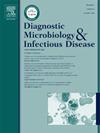Mechanism of Helicobacter pylori vacuolar cytotoxin a-induced gastric mucosal atrophy: A histopathological and immunohistochemical analysis
IF 2.1
4区 医学
Q3 INFECTIOUS DISEASES
Diagnostic microbiology and infectious disease
Pub Date : 2025-03-07
DOI:10.1016/j.diagmicrobio.2025.116785
引用次数: 0
Abstract
Objective
This study aims to examine the underlying mechanism of gastric mucosal atrophy induced by vacuolar cytotoxin A (VacA) produced by Helicobacter pylori.
Methods
A total of 942 endoscopic biopsy and endoscopic submucosal dissection samples of gastric mucosa infected with H. pylori were subjected to detailed histomorphological and immunohistochemical analysis.
Results
H. pylori exhibited specific adherence to surface mucus cells, proliferating extensively while producing and secreting VacA. The atrophic process was initiated by the upward migration and compensatory proliferation of cells in the deeper regions of the gastric pit, isthmus, and mucous neck cells. VacA disrupted the normal physiological organization and polarity of the proliferative zone, altering the proliferation patterns and directional growth of stem cells. This disruption resulted in a disordered state of cell proliferation.
Insufficient downward migration of cells within the proliferative zone led to atrophy of the lamina propria glands in the gastric mucosa. This process was accompanied by epithelial cell proliferation and transformation, along with interstitial infiltration of lymphocytes, a small number of plasma cells, and neutrophils. These histopathological changes ultimately contributed to the characteristic atrophic gastritis associated with H. pylori infection.
Conclusion
A comprehensive understanding of the histopathological features of VacA-induced gastric mucosal atrophy is essential for the prevention and management of H. pylori-related gastric carcinogenesis.
幽门螺杆菌空泡细胞毒素A诱导胃粘膜萎缩的机制:组织病理学和免疫组织化学分析
目的探讨幽门螺杆菌产生的空泡细胞毒素A (VacA)致胃粘膜萎缩的机制。方法对942例胃黏膜幽门螺旋杆菌感染的内镜活检和内镜黏膜下解剖标本进行详细的组织形态学和免疫组织化学分析。幽门螺杆菌表现出对表面黏液细胞的特异性粘附,在产生和分泌VacA的同时广泛增殖。萎缩过程是由胃窝、峡部和粘膜颈部较深区域的细胞向上迁移和代偿性增殖引起的。VacA破坏了干细胞增殖区的正常生理组织和极性,改变了干细胞的增殖模式和定向生长。这种破坏导致细胞增殖的无序状态。增生带内细胞向下迁移不足导致胃粘膜固有层腺萎缩。这一过程伴随着上皮细胞的增殖转化,并伴有淋巴细胞、少量浆细胞和中性粒细胞的间质浸润。这些组织病理学改变最终导致了与幽门螺杆菌感染相关的特征性萎缩性胃炎。结论全面了解vaca诱导胃粘膜萎缩的组织病理学特征,对预防和治疗幽门螺杆菌相关胃癌至关重要。
本文章由计算机程序翻译,如有差异,请以英文原文为准。
求助全文
约1分钟内获得全文
求助全文
来源期刊
CiteScore
5.30
自引率
3.40%
发文量
149
审稿时长
56 days
期刊介绍:
Diagnostic Microbiology and Infectious Disease keeps you informed of the latest developments in clinical microbiology and the diagnosis and treatment of infectious diseases. Packed with rigorously peer-reviewed articles and studies in bacteriology, immunology, immunoserology, infectious diseases, mycology, parasitology, and virology, the journal examines new procedures, unusual cases, controversial issues, and important new literature. Diagnostic Microbiology and Infectious Disease distinguished independent editorial board, consisting of experts from many medical specialties, ensures you extensive and authoritative coverage.

 求助内容:
求助内容: 应助结果提醒方式:
应助结果提醒方式:


